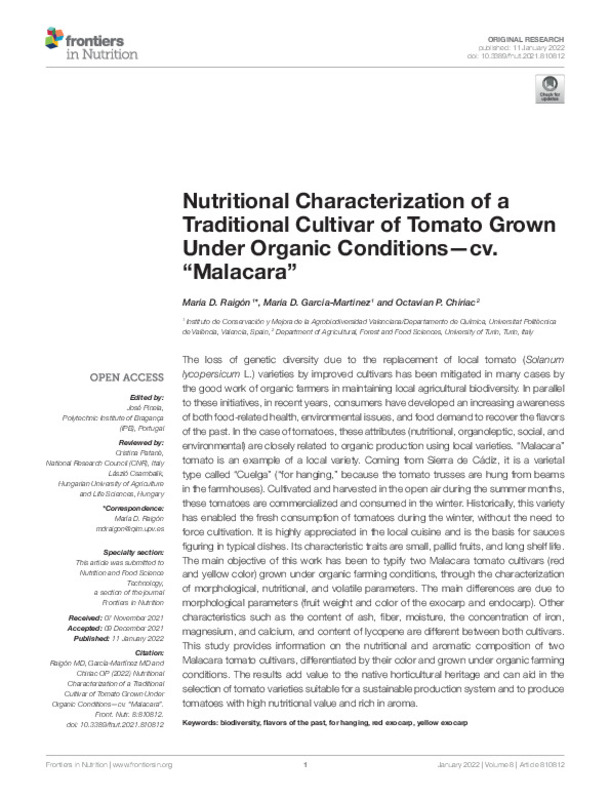JavaScript is disabled for your browser. Some features of this site may not work without it.
Buscar en RiuNet
Listar
Mi cuenta
Estadísticas
Ayuda RiuNet
Admin. UPV
Nutritional characterization of a traditional cultivar of tomato grown under organic conditions¿ cv. ¿Malacara¿
Mostrar el registro sencillo del ítem
Ficheros en el ítem
| dc.contributor.author | Raigón Jiménez, Mª Dolores
|
es_ES |
| dc.contributor.author | García-Martínez, María Dolores
|
es_ES |
| dc.contributor.author | Chiriac, Octavian P.
|
es_ES |
| dc.date.accessioned | 2022-10-07T18:06:54Z | |
| dc.date.available | 2022-10-07T18:06:54Z | |
| dc.date.issued | 2022-01-11 | es_ES |
| dc.identifier.uri | http://hdl.handle.net/10251/187288 | |
| dc.description.abstract | [EN] The loss of genetic diversity due to the replacement of local tomato (Solanum lycopersicum L.) varieties by improved cultivars has been mitigated in many cases by the good work of organic farmers in maintaining local agricultural biodiversity. In parallel to these initiatives, in recent years, consumers have developed an increasing awareness of both food-related health, environmental issues, and food demand to recover the flavors of the past. In the case of tomatoes, these attributes (nutritional, organoleptic, social, and environmental) are closely related to organic production using local varieties. "Malacara" tomato is an example of a local variety. Coming from Sierra de Cadiz, it is a varietal type called "Cuelga" ("for hanging," because the tomato trusses are hung from beams in the farmhouses). Cultivated and harvested in the open air during the summer months, these tomatoes are commercialized and consumed in the winter. Historically, this variety has enabled the fresh consumption of tomatoes during the winter, without the need to force cultivation. It is highly appreciated in the local cuisine and is the basis for sauces figuring in typical dishes. Its characteristic traits are small, pallid fruits, and long shelf life. The main objective of this work has been to typify two Malacara tomato cultivars (red and yellow color) grown under organic farming conditions, through the characterization of morphological, nutritional, and volatile parameters. The main differences are due to morphological parameters (fruit weight and color of the exocarp and endocarp). Other characteristics such as the content of ash, fiber, moisture, the concentration of iron, magnesium, and calcium, and content of lycopene are different between both cultivars. This study provides information on the nutritional and aromatic composition of two Malacara tomato cultivars, differentiated by their color and grown under organic farming conditions. The results add value to the native horticultural heritage and can aid in the selection of tomato varieties suitable for a sustainable production system and to produce tomatoes with high nutritional value and rich in aroma. | es_ES |
| dc.language | Inglés | es_ES |
| dc.publisher | Frontiers Media S.A. | es_ES |
| dc.relation.ispartof | Frontiers in Nutrition | es_ES |
| dc.rights | Reconocimiento (by) | es_ES |
| dc.subject | Biodiversity | es_ES |
| dc.subject | Flavors of the past | es_ES |
| dc.subject | For hanging | es_ES |
| dc.subject | Red exocarp | es_ES |
| dc.subject | Yellow exocarp | es_ES |
| dc.subject.classification | EDAFOLOGIA Y QUIMICA AGRICOLA | es_ES |
| dc.title | Nutritional characterization of a traditional cultivar of tomato grown under organic conditions¿ cv. ¿Malacara¿ | es_ES |
| dc.type | Artículo | es_ES |
| dc.identifier.doi | 10.3389/fnut.2021.810812 | es_ES |
| dc.rights.accessRights | Abierto | es_ES |
| dc.contributor.affiliation | Universitat Politècnica de València. Departamento de Química - Departament de Química | es_ES |
| dc.description.bibliographicCitation | Raigón Jiménez, MD.; García-Martínez, MD.; Chiriac, OP. (2022). Nutritional characterization of a traditional cultivar of tomato grown under organic conditions¿ cv. ¿Malacara¿. Frontiers in Nutrition. 8:1-13. https://doi.org/10.3389/fnut.2021.810812 | es_ES |
| dc.description.accrualMethod | S | es_ES |
| dc.relation.publisherversion | https://doi.org/10.3389/fnut.2021.810812 | es_ES |
| dc.description.upvformatpinicio | 1 | es_ES |
| dc.description.upvformatpfin | 13 | es_ES |
| dc.type.version | info:eu-repo/semantics/publishedVersion | es_ES |
| dc.description.volume | 8 | es_ES |
| dc.identifier.eissn | 2296-861X | es_ES |
| dc.identifier.pmid | 35087858 | es_ES |
| dc.identifier.pmcid | PMC8786908 | es_ES |
| dc.relation.pasarela | S\453999 | es_ES |
| dc.contributor.funder | Universitat Politècnica de València | es_ES |
| dc.subject.ods | 02.- Poner fin al hambre, conseguir la seguridad alimentaria y una mejor nutrición, y promover la agricultura sostenible | es_ES |
| upv.costeAPC | 2420 | es_ES |








